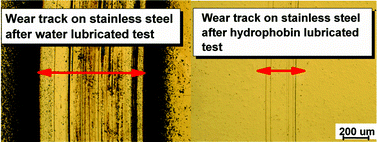Macroscale tribological properties of hydrophobin layers bound on stainless steel surfaces were investigated in an aqueous environment. Emphasis was on boundary lubrication because water easily fails in hydrodynamic lubrication due to its low viscosity. We studied the affinities of two different proteins, HFBI and FpHYD5, on stainless steel and their ability to bind water at the surface by combining quartz crystal microbalance (QCM-D) and ellipsometry. Both proteins contained an adhesive hydrophobic domain, but FpHYD5 also had a very strongly hydrating carbohydrate structure attached to it. The lubrication properties of the proteins were studied with two different methods, pin-on-disc (POD) (stainless steel vs. stainless steel) and circular translation pin-on-disc (CTPOD) (UHMWPE vs. stainless steel). It was observed that both hydrophobins could adhere to the stainless steel surface and form highly hydrated layers. Both proteins reduced friction and wear of the sliding contact between two stainless steel surfaces. With UHMWPE against stainless steel, the hydrophobins prevented the polyethylene transfer to the counterface. The lowest coefficient of friction (COF) 0.13 was observed when FpHYD5 hydrophobins were employed in pure water. On the other hand, the lowest wear was observed when FpHYD5 proteins were added in a 50 mM sodium acetate buffer. Increasing the water content and loosening the hydrophobin film structure on the stainless steel surface led to a reduction in friction and wear.

You have access to this article
 Please wait while we load your content...
Something went wrong. Try again?
Please wait while we load your content...
Something went wrong. Try again?


 Please wait while we load your content...
Please wait while we load your content...